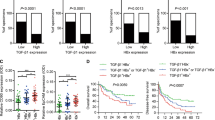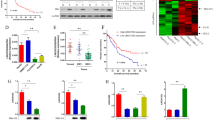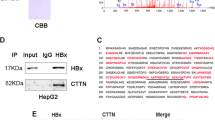Abstract
Hepatitis B virus (HBV)-encoded X antigen (HBxAg) contributes to the development of hepatocellular carcinoma (HCC). A frequent characteristic of HCC is reduced or absent expression of the cell adhesion protein, E-cadherin, although it is not known whether HBxAg plays a role. To address this, the levels of E-cadherin were determined in HBxAg-positive and -negative HepG2 cells in culture, and in tumor and surrounding nontumor liver from a panel of HBV carriers. The results showed an inverse relationship between HBxAg and E-cadherin expression both in tissue culture and in vivo. In HBxAg-positive cells, E-cadherin was suppressed at both the mRNA and protein levels. This was associated with hypermethylation of the E-cadherin promoter. Depressed E-cadherin correlated with HBxAg trans-activation function, as did the migration of HepG2 cells in vitro. Decreased expression of E-cadherin was also associated with the accumulation of β-catenin in the cytoplasm and/or nuclei in tissues and cell lines, which is characteristic of activated β-catenin. Additional work showed that HBxAg-activated β-catenin. Together, these results suggest that the HBxAg is associated with decreased expression of E-cadherin, accumulation of β-catenin in the cytoplasm and nucleus, and increased cell migration, which may contribute importantly to hepatocarcinogenesis.
This is a preview of subscription content, access via your institution
Access options
Subscribe to this journal
Receive 50 print issues and online access
$259.00 per year
only $5.18 per issue
Buy this article
- Purchase on Springer Link
- Instant access to full article PDF
Prices may be subject to local taxes which are calculated during checkout






Similar content being viewed by others
References
Bae SH, Jung ES, Park YM, Jang JW, Choi JY, Cho SH et al. (2002). Korean J Hepatol 8: 297–303.
Calvisi DF, Ladu S, Conner EA, Factor VM, Thorgeirsson SS . (2004). Lab Invest 84: 1137–1147.
Caselmann WH . (1995). J Hepatol 22 (Suppl 1): 34–37.
Cha MY, Kim CM, Park YM, Ryu WS . (2004). Hepatology 39: 1683–1693.
Christofori G, Semb H . (1999). Trends Biochem Sci 24: 73–76.
Endo K, Ueda T, Ueyama J, Ohta T, Terada T . (2000). Human Pathol 31: 558–565.
Feitelson MA, Duan LX . (1997). Am J Pathol 150: 1141–1157.
Feitelson MA, Reis H, Pan J, Lian Z, Fang J, Liu J et al. (1999) In: Fleig WE (ed). Normal and Malignant Liver Cell Growth: FALK Workshop. Kluwer Academic Publishers: Lancaster, UK. pp 156–170.
Feitelson MA, Sun B, Satiroglu Tufan NL, Liu J, Pan J, Lian Z . (2002). Oncogene 21: 2593–2604.
Gottardi CJ, Wong E, Gumbiner BM . (2001). J Cell Biol 153: 1049–1060.
Henkler F, Koshy R . (1996). J Viral Hepat 3: 109–121.
Herman JG, Graff JR, Myohanen S, Nelkin BD, Baylin SB . (1996). Proc Natl Acad Sci USA 93: 9821–9826.
Inayoshi J, Ichida T, Sugitani S, Tsuboi Y, Genda T, Honma N et al. (2003). J Gastroenterol Hepatol 18: 673–677.
Jiao W, Miyazaki K, Kitajima Y . (2002). Br J Cancer 86: 98–101.
Kanai Y, Tsuda H, Sakamoto M, Hirohashi S . (2000). Cancer Lett 148: 73–80.
Kanai Y, Ushijima S, Hui AM, Ochiai A, Tsuda H, Sakamoto M et al. (1997). Int J Cancer 71: 355–359.
Kondoh N, Wakatsuki T, Hada A, Shuda M, Tanaka K, Arai M et al. (2001). Int J Oncol 18: 1271–1278.
Lara-Pezzi E, Majano PL, Yanez-Mo M, Gomez-Gonzalo M, Carretero M, Moreno-Otero R et al. (2001a). J Hepatol 34: 409–415.
Lara-Pezzi E, Roche S, Andrisani OM, Sanchez-Madrid F, Lopez-Cabrera M . (2001c). Oncogene 20: 3323–3331.
Lara-Pezzi E, Serrador JM, Montoya MC, Zamora D, Yanez-Mo M, Carretero M et al. (2001b). Hepatology 33: 1270–1281.
Lee S, Lee HJ, Kim JH, Lee HS, Jang JJ, Kang GH . (2003). Am J Pathol 163: 1371–1378.
Lian Z, Liu J, Li L, Li X, Tufan NLS, Clayton MM et al. (2003). Neoplasia 5: 229–244.
Lian Z, Pan J, Liu J, Zhang S, Zhu M, Arbuthnot P et al. (1999). Oncogene 18: 1677–1687.
Liu J, Feitelson MA . (2004). Methods Mol Med 95: 71–84.
Masuda T, Saito H, Kaneko F, Atsukawa K, Morita M, Inagaki H et al. (2000). In vitro Cell Dev Biol 36: 387–394.
Matsumura T, Makino R, Mitamura K . (2001). Clin Cancer Res 7: 594–599.
Nelson WJ, Nusse R . (2004). Science 303: 1483–1487.
Orsulic S, Huber O, Aberle H, Arnold S, Kemler R . (1999). J Cell Sci 112: 1237–1245.
Prange W, Breuhahn K, Fischer F, Zilkens C, Pietsch T, Petmecky K et al. (2003). J Pathol 201: 250–259.
Slagle BL, Zhou YZ, Birchmeier W, Scorsone KA . (1993). Hepatology 18: 757–762.
Su Q, Liu JF, Zhang SX, Li DF, Yang JJ . (1994). Hepatology 19: 788–799.
Sun BS, Zhu X, Clayton MM, Pan J, Feitelson MA . (1998). Hepatology 27: 228–239.
Terradillos O, Billet O, Renard CA, Levy R, Molina T, Briand P et al. 1997. Oncogene 14: 395–404.
Truant R, Antunovic J, Greenblatt J, Prives C, Cromlish JA . (1995). J Virol 69: 1851–1859.
Vandeputte DA, Troost D, Leenstra S, Ijlst-Keizers H, Ramkema M, Bosch DA et al. (2002). Glia 38: 329–338.
Wang W, London WT, Lega L, Feitelson MA . (1991). Hepatology 14: 29–37.
Wang XW, Forrester K, Yeh H, Feitelson MA, Gu JR, Harris CC . (1994). Proc Natl Acad Sci USA 91: 2230–2234.
Wei Y, Van Nhieu JT, Prigent S, Srivatanakul P, Tiollais P, Buendia MA . (2002). Hepatology 36: 692–701.
Wong AST, Gumbiner BM . (2003). J Cell Biol 161: 1191–1203.
Wong CM, Fan ST, Ng IO . (2001). Cancer 92: 136–145.
Wu JC, Merlino G, Fausto N . (1994). Proc Natl Acad Sci USA 91: 674–678.
Yang B, Guo M, Herman JG, Clark DP . (2003). Am J Pathol 163: 1101–1107.
Yano T, Hernandez-Blazquez FJ, Omori Y, Yamasaki H . (2001). Carcinogenesis 22: 1593–1600.
Acknowledgements
This work was supported by NIH Grants CA48656 and CA66971 to MAF.
Author information
Authors and Affiliations
Corresponding author
Rights and permissions
About this article
Cite this article
Liu, J., Lian, Z., Han, S. et al. Downregulation of E-cadherin by hepatitis B virus X antigen in hepatocellullar carcinoma. Oncogene 25, 1008–1017 (2006). https://doi.org/10.1038/sj.onc.1209138
Received:
Revised:
Accepted:
Published:
Issue Date:
DOI: https://doi.org/10.1038/sj.onc.1209138
Keywords
This article is cited by
-
Ribosomal protein S15a promotes tumor angiogenesis via enhancing Wnt/β-catenin-induced FGF18 expression in hepatocellular carcinoma
Oncogene (2018)
-
Cdc6 expression is induced by HPV16 E6 and E7 oncogenes and represses E-cadherin expression
Cancer Gene Therapy (2016)
-
Comparative study of the different activities of hepatitis B virus whole-X protein and HBx in hepatocarcinogenesis by proteomics and bioinformatics analysis
Archives of Virology (2015)
-
Synergistic function of Kras mutation and HBx in initiation and progression of hepatocellular carcinoma in mice
Oncogene (2014)
-
Efficacy of early treatment on 52 patients with preneoplastic hepatitis B virus-associated hepatocellular carcinoma by compound Phyllanthus Urinaria L.
Chinese Journal of Integrative Medicine (2014)



